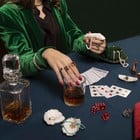Shop since 1973 100% recycled and restoredSame day shipping
Carnelian: A fiery gemstone
Carnelian is a variant of the mineral chalcedony, which occurs in many color variants, with carnelian having a light yellow to deep orange color. The mineral, like onyx, also occurs in colored bands. Carnelian is one of the first gemstones that was worn by humans because it is relatively soft and therefore easy to work. Because the stone comes in so many different colors, it is a very popular material for jewellery.

Tutankhamun loved carnelian
The use of carnelian in jewellery has a long history. More than 4,500 years ago, Egyptian craftsmen were already making jewellery set with this gemstone. The Egyptians believed that the stone would protect souls in the afterlife: the pharaoh Tutankhamun had various carnelian jewellery in his tomb. The ancient Romans and Greeks also appreciated the stone, which they used for signet rings, set with intaglio. An intaglio is an engraving technique in which a representation is cut into a mineral, which is therefore visible in the lower layers of the stone. The opaque color and the relative softness of carnelian make this gemstone very suitable for engraving. The word carnelian comes from the Latin word 'carneus', which means fleshy, a reference to the color of the stone. In the Netherlands, carnelian was also very popular in the 19th and early 20th century for use in regional jewellery. Relatively large, faceted beads could be cut from carnelian, which were then worn with gold clasps. Also, carnelian were often rose cut – either faceted at the top and with a flat bottom – and worn in rings, earrings and brooches.
Soft and warm
Carnelian can range in color from reddish orange to brownish, yellow, orange to brown. The different shades of orange/red depend on the amount of iron oxide present in each stone. Carnelian can be uniform in color but also occurs with streaked layers: these stones are often used to carve cameos. Carnelian is a relatively soft stone, which makes it easy to cut into various shapes, and is transparent to slightly translucent.
Roots in Brazil and Uruguay
Because chalcedony occurs all over the world, carnelian is a relatively cheap gemstone. Unlike many gemstones, carnelian is actually always opaque and therefore the color mainly influences the quality. Because it is opaque, it is usually cut as a cabochon or rose cut, or used for beads and intaglio. The gemstone comes in different shades of yellow and orange, with deep orange being the most popular. Most of the carnelian found on the market today is treated chalcedony from Brazil or Uruguay, which has been heated to obtain its most popular color, an intense orange.
Discover the most beautiful collection of vintage carnelian jewellery here .


